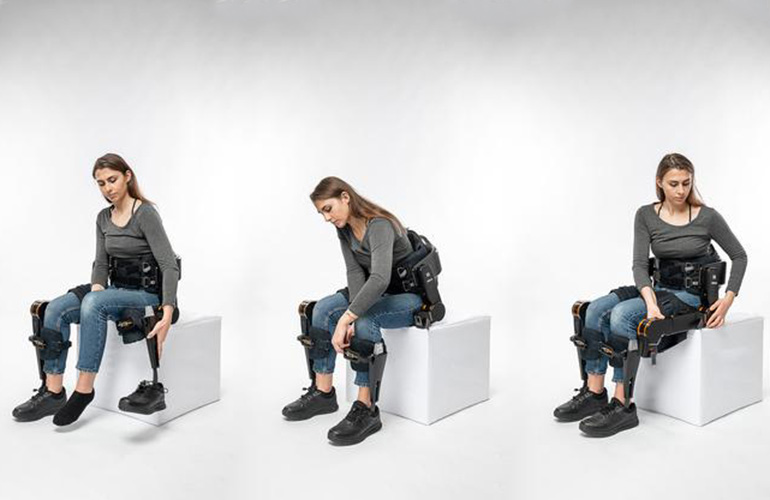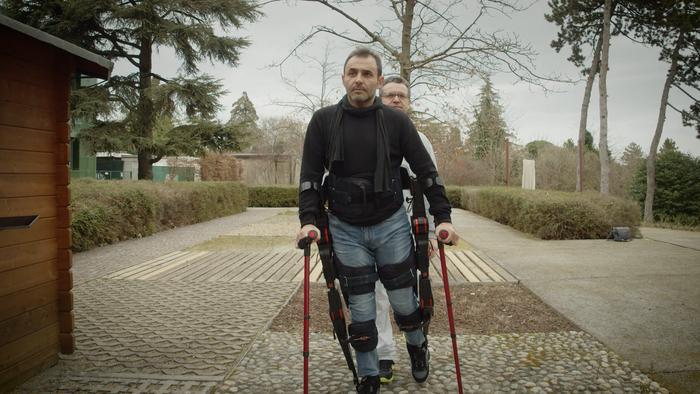|
Listen to this article |

TWIN is made of lightweight materials, and it has modular components for usability and transportation. | Source: IIT
Italian researchers last week announced the TWIN powered exoskeleton for lower limbs. They said they have designed it to be easier to wear than competing exoskeletons on the market.
TWIN is the product of a collaboration between Rehab Technologies IIT – INAIL, the joint laboratory between the Istituto Italiano di Tecnologia (IIT– Italian Institute of Technology) in Genoa, and the Prosthetic Center of INAIL, the prosthetic unit of the National Institute for Insurance against Accidents at Work in Bologna. IIT’s Matteo Laffranchi coordinated the project, which began in 2013 with the goal of developing innovative, high-tech, cost-effective systems for patients with physical impairments.
The researchers presented TWIN during a press conference at the Museum of Science and Technology in Milan. Two patients who had been involved in testing the system demonstrated the exoskeleton.
One of the patients was Alex Santucci, who had worked with technicians and researchers throughout the project’s design phase and who participated in clinical experiments as a tester (see photo below). The clinical experiments took place at the Prosthetic Center of INAIL in Vigorso di Budrio, the Montecatone Rehabilitation Institute in Imola, and illa Beretta in Costa Masnaga (LC).

Alex Santucci demonstrated the TWIN lower-limb exoskeleton. Source: IIT-Istituto Italiano di Tecnologia
Exoskeleton designed for portability, ease of use
TWIN is intended to enhance the physical abilities of the wearer, according to the research organizations. While the exoskeleton is just a prototype now, the collaborators said they hope to bring it to market soon.
The researchers designed TWIN to allow individuals with reduced or even absent motor abilities in their lower limbs to maintain an upright position. This can include people with complete spinal cord injuries.
The exoskeleton is not self-balancing, but it can enable wearers to walk with the assistance of crutches or walkers and to stand up and sit down, said the researchers in a release.
The researchers said TWIN has two unique features that make it stand out. The first is that it’s made of lightweight materials such as aluminum alloy. The second is that the system contains modular components to further facilitate usability and transportability.
The structure of TWIN is adjustable based on the patient’s physical characteristics. It can be adjusted using telescopic links placed at the level of the femur and the tibia. The team also made ankle and foot support available in various sizes. This is so TWIN can adapt to the ergonomics of the user, whether they are male or female, young or an adult.
The TWIN motors activate the knee and hip joints, imposing a completely configurable movement pattern on the patient’s limbs, in terms of step length and type, and walking speed. The battery has a lifespan of approximately four hours and requires and hour to recharge.
TWIN features three operating models that also adapt to the patient. The exoskeleton evaluates the degree of motor deficit of the person wearing it, particularly their ability to perform autonomous walking. The exoskeleton’s operating modes are:
- Walk mode: The team designed this for patients with absent motor function. In this mode, the exoskeleton imposes a walking pattern according to programmed parameters.
- Retrain mode: Retrain mode is for patients with partial impairment of lower-limb motor function who are capable of performing a more or less autonomous movement but face some difficulties in some phases of the steps. In this case, the exoskeleton supports the patient’s movement with more or less intensity, directing them toward an optimal reference trajectory.
- TwinCare mode: The team designed this mode for patients with partial and differentiated motor impairment between two limbs. In this case, one leg might be healthy and can move autonomously, while the other requires assistance in some phases of the step.
What comes next for TWIN?
An operator, such as a physiotherapist in a rehabilitation clinic, can control TWIN using a specific Android app installed on the included tablet. The graphical interface allows for controlling the exoskeleton in the execution of various programmed activities, setting the kinematic parameters of movement, and choosing between different step execution modes.
In addition to rehabilitation clinics during physiotherapy sessions, TWIN can be worn daily even just for a few hours. Assuming the upright position brings significant benefits in terms of musculoskeletal circulatory, psychological, and digestive system functionality for wheelchair users, said the developers.
They added that their next goal for TWIN is CE marking. They are working with a partner on European certification, which will be followed by the industrialization process. Once TWIN is on the market, it can be used by patients in need, reintegrating severely injured workers into social and work environments, said the researchers.
 Learn from Agility Robotics, Amazon, Disney, Teradyne and many more.
Learn from Agility Robotics, Amazon, Disney, Teradyne and many more.





